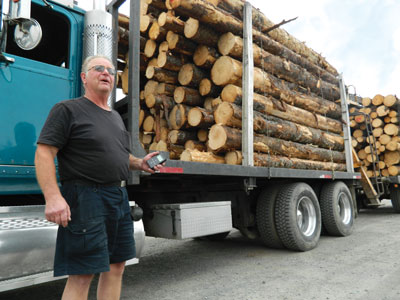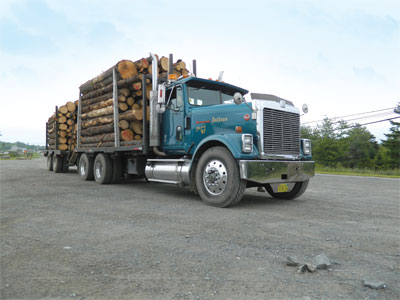
Features
Columns
Education
By the Numbers
Whether on the truck or on the loader, weigh scales allow truckers to haul the maximum weight
April 18, 2012 By James Menzies
With advances in mobile scale technologies, it’s now possible to weigh product at virtually any point along the supply chain.
With advances in mobile scale technologies, it’s now possible to weigh product at virtually any point along the supply chain. This provides unprecedented opportunities to improve productivity and to make overweight violations a thing of the past.
 |
|
| Forestry is a large market for onboard scale systems, and Richard Countway of Nova Scotia has relied on one for years.
|
On-board weighing systems for trucks and loading equipment are more accurate than ever and design improvements have also made them more robust, which is crucial in the aggregates and roadbuilding businesses.
Here’s a look at some options for weighing product in the pit and on the go.
On-board truck scales
On-board truck scales may seem unnecessary today, with practically all quarry operations and other aggregate sites equipped with in- or above-ground truck scales. However, suppliers of on-board truck scales say that after forestry and agriculture, aggregates remains one of their biggest markets. For one, truckers enjoy the peace of mind in knowing they’re not overloaded at sites where overloading remains a problem.
They also allow truck drivers to ensure they’re loaded to capacity and not leaving payload on the table.
There are on-board weighing systems available for virtually any configuration of truck and trailer. TruckWeight, manufactured by Halifax, N.S.-based Smart Scale Technologies, has developed a system that uses strain gauge sensors for vehicles with mechanical suspensions, which measure weight based on the deflection of the axle. It also has standard air sensor systems for trucks and trailers with air suspensions, and the two systems can be combined on vehicle combinations with both mechanical and air ride suspensions.
The aggregates business is the third most popular market for TruckWeight, president Peter Panagapko says. One of the benefits is that truckers can avoid making trips back to the stockpile to dump product or to receive another bucketful if they’re over- or under loaded when they drive across the truck scale.
Other types of on-board weigh systems for trucks use strategically placed load cells to measure weight in much the same way as a digital bathroom scale. These systems are significantly more expensive but are generally believed to deliver the greatest accuracy. Bryce Molander of Vulcan On-Board Scales’ Port Coquitlam, B.C. office says “Load cells are the most accurate way to go for any scale system. They rate them to within 1%, but usually you’ll get them to within 0.5% of GVW.”
They are, however, significantly more expensive than the alternatives. John Hughes, vice-president of business development with Rice Lake Weighing Systems, says his company offers both air sensor and load cell-based systems for trucks. The load cell systems, he says, are “a little more accurate and about four to five times the cost.”
Since truckers are generally using on-board scales for compliance reasons, Hughes said most opt for the less expensive options. For that reason, many suppliers offer a complete line of products ranging in price from just over $1,000 to as much as $12,000.
Loading equipment scales
Wheel loader scales are becoming more popular at quarries and other work sites as well. Mike Clarke, president of Silver Top Supply, an Ontario dealer for Loadrite on-board loader scales, says more companies are now equipping their loaders with on-board scales.
 |
|
| Still, supplier TruckWeight says aggregates is the third most popular market for its on-board scale system. |
“When we started in the business back in the 1980s, it was kind of a new thing,” he says. “But now, once they have a loader with a scale on it and they get into one without it, they say ‘Geez, we need a scale’.”
Loadrite recently obtained Legal-for-Trade certification, which means it’s confirmed to be accurate to within 0.5%. The biggest advantage to using loader scales is that operators are able to load a truck to capacity the first time, so the truck driver doesn’t have to return to dump product or be topped off after crossing the in-ground scale.
“Time is money,” says Clarke. “You want to make sure it’s loaded accurately right at the stockpile.”
Wheel loader operators can monitor weights using an in-cab display with a keypad, which allows them to measure the weight of each bucket as well as the truck and/or trailer load. The operator can simply punch in his desired payload and count up or down until it’s reached. They can even store specific parameters for up to 600 individual truck operators using the Loadrite system, Clark explains.
VEI Loader Scales has also added new capabilities to its system, allowing the operator to program everything into the system from the customer name, product and destination to the volume of the total truck load, number of buckets and machine codes.
“With these scales, our equipment customers are using their loader bucket like a giant measuring cup,” explains Bob Prichett of General Equipment, a North Dakota distributor of VEI Loader Scales. He claims nearly every aggregate site he visits now is running loader scales.
“You sell the first one and they sell themselves after that,” he says.
Still, not everyone is a fan. Rice Lake’s Hughes says vehicle scales are still the most accurate and efficient way to weigh product.
“They are very troublesome from a service and installation perspective,” Hughes says of loader scales, noting Rice Lake currently doesn’t offer one for those very reasons.
Silver Top’s Clarke, disagrees, suggesting “If you’re loading anything, you should be tracking how much you’re loading to make sure you’re not under loading and overloading and also for the efficiency of your operations.”
To that end, Loadrite now offers an excavator scale, which Clarke says is beginning to attract some attention.
“It’s a newer product for us, so it’s taking some time for people to realize the benefits,” he says.
Other alternatives
In the opinion of Rice Lake’s Hughes, the optimal solution is to weigh product as it’s being loaded by installing a scale right underneath the hopper that fills the truck and then using a certified in-ground scale to ensure the truck’s legal before it leaves the facility.
“If you’re weighing from the hopper, that weight is fairly accurate, usually to within 1%,” Hughes points out, adding many loader scales are only accurate to within 3% which leaves plenty of room for error when dealing with loads of 25 tonnes.
When it comes to choosing a vehicle scale, the options are endless, with everything from deck material to installation method up for discussion.
James Menzies is a seasoned trucking writer based in Ontario. He wrote this article for Aggregates & Roadbuilding.
Print this page